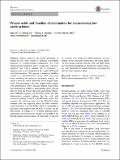Precise orbit and baseline determination for maneuvering low earth orbiters
Author(s)
Gu, Defeng; Allende-Alba, Gerardo; Montenbruck, Oliver; Wang, Zhengming; Herring, Thomas A; Ju, Bing; ... Show more Show less
Download10291_2015_Article_505.pdf (3.899Mb)
OPEN_ACCESS_POLICY
Open Access Policy
Creative Commons Attribution-Noncommercial-Share Alike
Terms of use
Metadata
Show full item recordAbstract
Orbital maneuvers are usually performed as needed for low earth orbiters to maintain a predefined trajectory or formation-flying configuration. To avoid unexpected discontinuities and to connect pre- and post-maneuver arcs with a minimal set of parameters, a maneuver has to be considered in the routine GPS-based orbit determinations. We propose a maneuver handling method in a reduced-dynamic scheme. With the proper thrust modeling and numerical integration strategy, the effects caused by orbital maneuver can be largely eliminated. The performance for both single-satellite precise orbit determination (POD) and inter-satellite precise baseline determination (PBD) is demonstrated using selected data sets from the Gravity Recovery and Climate Experiment (GRACE) mission. For the POD results, the orbit determination residuals indicate that the orbit with maneuver modeling is well fit to the GPS observations. The external orbit validation shows that the GRACE-B orbits obtained from our approach match the DLR reference orbits better than 3 cm (3D RMS), which is comparable to the result of the maneuver-free GRACE-A satellite. For the PBD results, on average 87 % of double-difference phase ambiguities can be resolved to integers and an RMS of the K-band ranging system residuals of better than 0.7 mm can be achieved, even though the orbital maneuver was performed on the spacecraft. Furthermore, the actual maneuver performance derived from the POD and PBD results provides rigorous feedback on the thruster system, which is not only beneficial for current maneuver assessment but also for future maneuver plans.
Date issued
2015-11Department
Massachusetts Institute of Technology. Department of Earth, Atmospheric, and Planetary SciencesJournal
GPS Solutions
Publisher
Springer Berlin Heidelberg
Citation
Ju, Bing et al. “Precise Orbit and Baseline Determination for Maneuvering Low Earth Orbiters.” GPS Solutions (2015): n. pag.
Version: Author's final manuscript
ISSN
1080-5370
1521-1886